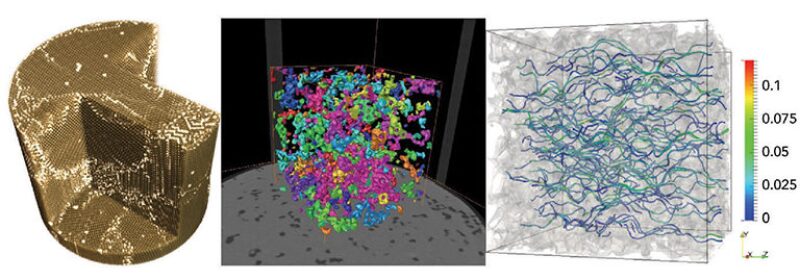Since the 1990s, X-ray computed tomography (CT) has become increasingly popular for its ability to yield big insights from tiny rock samples. But the volume of data produced from CT scanners is anything but tiny, and that makes sharing and storing the files a challenge.
In an effort to address this issue and foster collaboration in an area where there is currently very little, researchers at the University of Texas at Austin (UT) created a new web-based application called Digital Rocks Portal. In exchange for making their CT images of rocks available to outside researchers, the website will offer exploration companies free and unlimited data storage.
Maša Prodanović, the director of the Digital Rocks Portal and an assistant professor at UT’s petroleum and geosystems engineering department, said this arrangement will improve the industry’s understanding of rock microstructures and the accuracy of microscopic hydrocarbon flow models—valuable information that can be extrapolated to the reservoir scale.
“These are large data sets that require large computations, and this is a way to share them so that there is more verification and more confidence built into” the analytical process, she added.
As the samples being analyzed by a micro CT scanner get smaller, the energy and storage required to image them grows larger. For example, rock samples as small as 8 cubic millimeters may generate files of sizes between 700 MB and 30 GB. Such files are far too large to send over most email servers, and storage requirements can quickly balloon for companies carrying out extensive exploratory analysis.
Alternatively, companies can now use the digital rock portal and store all their data at UT’s advanced computer processing center, along with multiple backup servers. Companies who want to use the portal but keep their data private can do so for 2 years, after which they must either allow the data to enter the public domain, remove the data, or pay a fee to keep using the website.
As it awaits industry participation, UT has started to upload its repository of CT rock data and researchers from other institutions have signed on too, including Virginia Tech, Imperial College London, and Australian National University. In addition, one project from Petrobras, the Brazilian national oil and gas company, has been added to the portal.
Prodanović is also trying to market the portal as a way for companies to preserve their rock data, something she sees as an advantageous feature during these tumultuous times.
“The person who has been in charge of imaging may move on to a different position, change companies, or they may get laid off as is happening right now, and there’s a high potential of a lot of information being lost,” she said.
But the free data management platform is just one of the incentives. The broader scope of the portal involves building an online community of geoscience, engineering, and student re-searchers that will work together to advance the budding discipline of digital rock physics and generate new ways to enhance productivity.
“This is not intended as a teaching tool,” said Mary Pettengill, the curator of Digital Rocks Portal, “but rather as a research tool with which existing datasets can continue to be useful to those studying porous materials, whether the researchers are academics or in commercial labs.”
Another future aim of the portal is to help standardize both the data format and the modeling algorithms used most often in the industry for rock analysis by making them built-in features that can be applied with the click of a mouse; no downloading of software will be necessary.
Each file will also contain metadata to identify the rocks and provide other contextual information, something not routinely done today but necessary for collaboration. This aspect of the portal will involve creating what is known as a “digital object identifier” for each sample to make its various properties searchable. The end product will be something akin to a OnePetro library for rock images that may also include citations and links to research papers written about a particular sample.
The project has received funding through next year from the US National Science Foundation, a government agency that sponsors engineering research through grants, but UT is hoping that it can establish a more sustainable business model to keep the website up and running for the long term.


